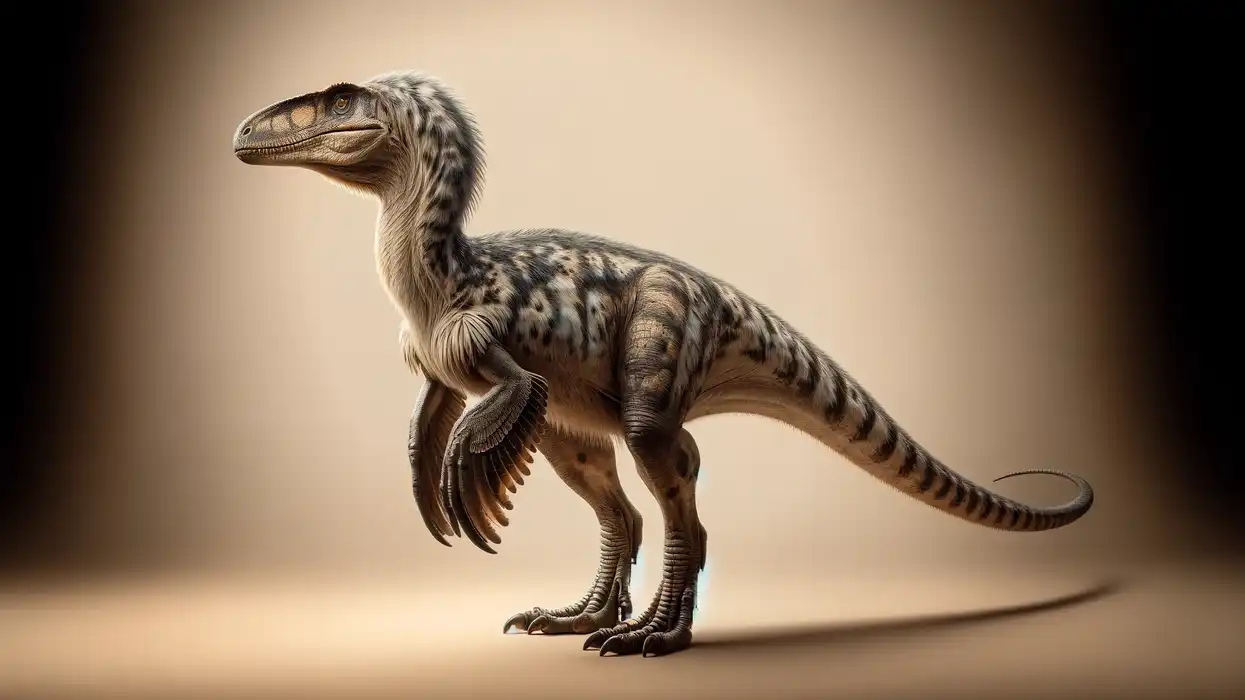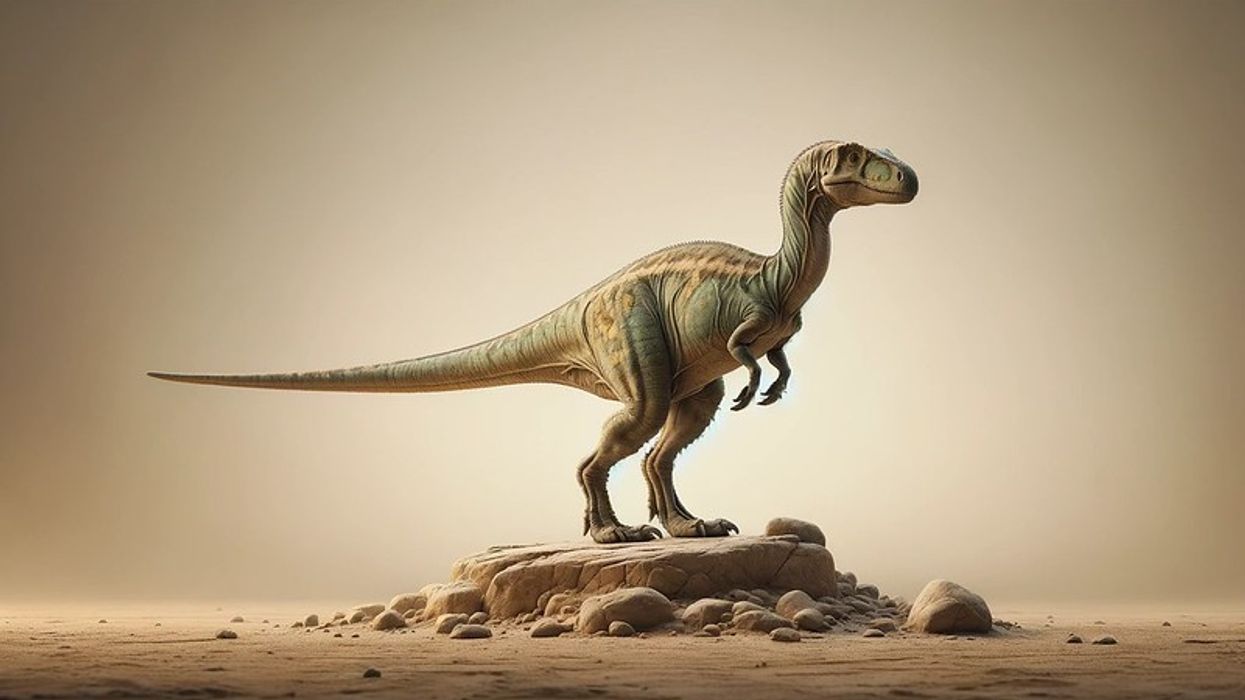During the early Jurassic Period, a dilophosaurid theropod dinosaur known as Dracovenator lived in South Africa approximately 200 million years ago. It was described and named in 2005 by Adam M. Yates. The name means, dragon hunter.
This medium-sized bipedal carnivore measured between 18-21.3 ft (5.5-6.5 m) in length. The weight and size of Dracovenator are 881.8 lb (400 kg) and 23 ft (7 m) respectively. Dracovenator inhabited the ground and was a moderately-built carnivore.
An incomplete Dracovenator skeleton skull was all that was recovered as its type specimen. It was reclassified from Syntarsus rhodesiensis to Dracovenator, a juvenile specimen.
An adult has a hand claw, an upper jaw, hip bones, backbones, including ribs, and foot bones. It may have similar-looking characteristics similar to Dilophosaurus. It was named a dragon hunter because of its carnivorous nature.
If you like reading about the Dracovenator, you might also like the Chungkingosaurus and the Homalocephale.
Dracovenator Interesting Facts
How do you pronounce 'Dracovenator'?
It is pronounced 'dra-co-ven-a-tor'. In the name of this genus, draco stands for 'dragon', and venator stands for 'hunter', thus meaning 'dragon hunter'.
What type of dinosaur was a Dracovenator?
Dracovenator regenti were theropods related to the family genus Dilophosauridae of the Animalia kingdom. The type species of Dracovenator is Dracovenator regenti, which was described and named in 2005 by Adam M. Yates. It was described as a new theropod dinosaur from the Early Jurassic era of South Africa and its implications for early theropod evolution.
In which geological period did the Dracovenator roam the earth?
The Dracovenator was found to roam the earth in and around Hettangian-Sinemurian in the early Jurassic period.
When did the Dracovenator become extinct?
The dinosaurs ceased to exist about 65 million years ago at the end of the Cretaceous period, they roamed the Earth during the early Jurassic time. The Dracovenator is assumed to have gone extinct around this time. Climate change on Earth may have been caused by large volcanic eruptions.
Where did a Dracovenator live?
Dracoventor's remains were found in the foothills of the Drakensberg, also known as dragon's mountain. It is also believed to have lived in the Upper Elliot Formation found in South Africa.
What was a Dracovenator's habitat?
The Dracovenator's habitat is believed to have been on land near forests.
Who did a Dracovenator live with?
From fossilized footprints called trackways, it is clear that dinosaurs traveled together. Herding behavior may have been associated with some dinosaur groups based on the finding of numerous track sites.
How long did a Dracovenator live?
The average lifespan of Dracovenator is 21 years. An incomplete Dracovenator skull was all that was recovered.
How did they reproduce?
According to the information collected, typically, a female will normally lay between 24-26 eggs per clutch. In the first year of life, hatchlings reached 4.9 ft (1.5 m) in length at the end of their first growth stage.
Adults take care of these juveniles. As with other extinct reptiles of comparable size, Dracoventor bauri invested a lot of energy in reproduction. When a juvenile grows up, it measures between 18-21.3 ft (5.5-6.5 m) in length.
Dracovenator Fun Facts
What did a Dracovenator look like?

Dracovenator's features are estimated to have measured between 18-21.3 ft (5.5-6.5 m) in length. Other estimates suggest that Dracovenator was 23 ft (7 m) long and weighed 881.8 lb (400 kg).
An articular bone, a bone fragment of the maxilla, two dentary fragments, two pieces of the surangular bone, three pieces of the angular bone, two pieces of the prearticular bone, and several teeth exist within the holotype specimen. Despite its small size, this dinosaur has kinks in its upper jaws between the premaxilla and maxilla.
Dilophosaurus also had lumps and bumps on the back end of its lower jaw.
The lump features on the lower jaw were much smaller in size. Based on Mutyikwa and Raath's research (1999), they reclassified paratype BP/1/5278 from Syntarsus rhodesiensis to Dracovenator, a juvenile specimen consisting of teeth, teeth roots, and jawbones.
A pair of crests may have been present on it, as on Dilophosaurus. Only the skull of this dinosaur was recovered.
A diagnosis specifies the anatomical features that distinguish an organism(s) from others. A diagnosis may also contain autapomorphies, but not necessarily all of them.
An autapomorphy is a distinctive characteristic of a given organism. According to research by Yates (2005) classification, this dragon hunter must have these features.
The presence of a broad bilobed fossa at the lateral premagnum foramen is connected by a deep, narrow channel at the alveolar margin.
The articular bone has an oblique notch, separating the retroarticular process from the posterior margin of the glenoid. There are also several well-developed tab-like processes on the dorsal surface, one on the medial surface, including chorda tympanic foramen, while the other is on the lateral side, just beyond the depressor mandibula fossa.
How many bones did a Dracovenator have?
According to an article published in 2006, Dracovenator regenti possesses a hand claw, an upper jaw, hip bones, back bones, ribs, and foot bones. The exact number of bones they had is unknown.
How did they communicate?
Several groups of fossil dinosaurs, some consisting of horns, frills, crests, sails, and feathers, have displayed visual display structures. This suggests that visual communication has always been one of the significant features of given dinosaur biology.
Color may have played a significant role in visual communication. There is less certainty about dinosaur vocalization's evolution. In some cases, Paleontologist Phil Senter suggests non-avian dinosaurs made sounds using non-vocal means like hissing, jaw grinding, clapping, splashing, and wing beating.
Apparently, dinosaurs could make closed-mouth vocalizations similar to cooing, which is found in crocodilians, birds, and other reptiles. Dracovenator vs Dilophosaurus has few similarities and both are related to the family genus Dilophosauridae.
How big was a Dracovenator?
A Dracovenator size is 18-21.3 ft (5.5-6.5 m). But some believe it to be 23 ft (7 m) long. It is quite large; being thrice the size of a giraffe.
How fast could a Dracovenator move?
The estimated walking speed of medium-sized, bipedal (two-legged) dinosaurs ranges from 2.5-3.7 mph (4-6 kph), while the estimated running speed ranges from 23-54.7 mph (37-88 kph).
How much did a Dracovenator weigh?
A Dracovenator dinosaur weighed roughly 880 lb (400 kg).
What were the male and female names of the species?
There are no sex-specific names for the Dracovenator.
What would you call a baby Dracovenator?
A baby Dracovenator is called a hatchling.
What did they eat?
They were believed to be carnivores but some pieces of evidence suggest they were omnivores. When we think of Dracovenator meaning dragon hunter, the name implies a skilled hunter capable of taking down magnificent prey.
Dracovenator was a plant-eating theropod that was often observed chewing on plants in reality. Its diet at large is composed of plants, despite its sharp teeth and powerful jaws.
While it collected plants as well as meat, it wasn't a very omnivorous animal. As well as amphibians, Dracovenator would feed on small dinosaurs and synapsids. It is a very intelligent species that uses strategic thinking and a pack hunting method.
An efficient pack coordinates its attacks, and its catch is split fairly among its members. The Dracovenator probably preyed upon prosauropod dinosaurs in the environment where they lived.
How aggressive were they?
Yes, they were aggressive. Their attacks were aggressive; if the prey was not disabled at the first strike, they would attack again and again.
Did you know...
A holotype and paratype specimen of this species are held in the fossil collection of the Evolutionary Studies Institute. A large part of the cranial material housed at Evolutionary Studies Institute has been lost, and no new fossils of Dracovenator have been discovered so far.
Dracoventor is quite a famous dinosaur and has quite a fandom. It is featured in the ark Dracovenator.
How did the Dracovenator get its name?
The word Draco means 'dragon', while Venator means 'hunter', so it is also called 'dragon hunter'. The dragon's mountain is known in Dutch as the Drakensberg, the mountain where it was discovered.
During Professor Kitching's fieldwork, Regent Lucas Huma served as an assistant to him under the name regenti. The type species, Dracovenator regenti, was named and described in 2005 by Adam M. Yates.
Did they take care of their babies?
Dinosaurs were supposedly very caring parents so they did take care of their babies. They were overprotective of their eggs.
Feathers were used to keep the egg warm, indicating that they were beginning to use an insulating layer. There is some evidence that the younger dinosaurs were provided with parental care because of the lack of teeth in their embryos.
Here at Kidadl, we have carefully created lots of interesting family-friendly dinosaur facts for everyone to discover! Learn more about some other creatures from our Ostafrikasaurus facts, or Rahonavis facts for kids.
You can even occupy yourself at home by coloring in one of our free printable swimming dinosaur coloring pages.









